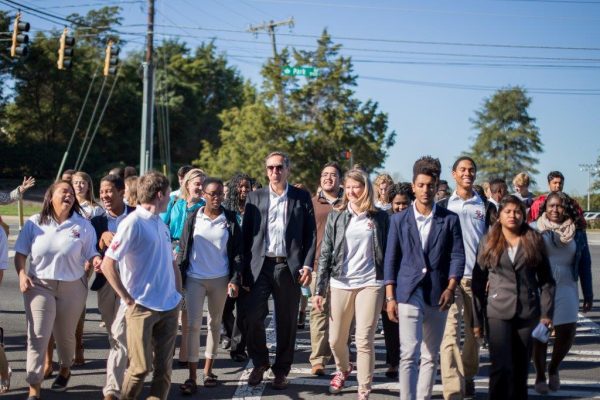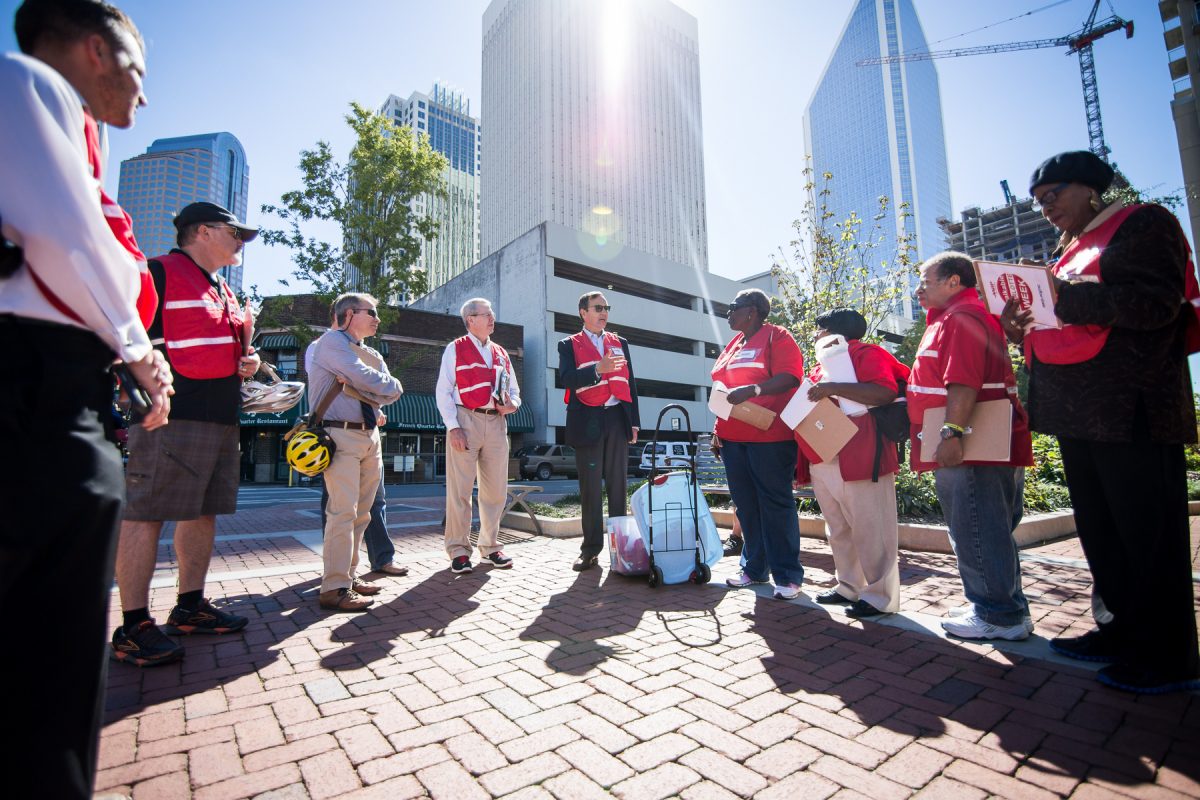Has Charlotte shifted toward welcoming cyclists, pedestrians?

It’s been only six weeks since globe-trotting “complete streets” advocate Gil Penalosa deplaned in Charlotte in October, wearing a slightly rumpled suit and armed with little more than a flash drive and a 500-slide PowerPoint. But what a week it was. By the end, I had a sense—no proof of course, but an intuition—that an important corner had been turned for this city built primarily for cars.
Hosted by the John S. and James L. Knight Foundation and the Southminster Retirement Community, Penalosa was hustled all over town, conducting a score of interviews, presentations and discussions, including a leadership breakfast at the BB&T Ballpark (where he got a standing ovation) and a walk-about with students from South Mecklenburg High School.
I first saw Penalosa in action in 1996 at a North American transportation conference in Madison, Wis. He was already gaining much attention as a global Pied Piper of sorts for the idea of streets as public places for human use and enjoyment. As executive director of Toronto-based nonprofit 8-80 Cities, he has advised more than 150 clients worldwide, convincing them that rapid and radical ways to conceive and design the streetscape are not as far-fetched as one might imagine. (“8-80” implies that anyone from age 8 to 80 has the right to share street space, regardless of choice of mobility.)
“Above all,” Penalosa says, “streets are more than viaducts for cars and trucks. Rather, they are a community’s most valuable real estate; they are the glue that bonds traffic, transit, pedestrians and cyclists to the necessities of daily life.”
Penalosa wasn’t the only act in town that week. The fourth annual BikeWalk NC Summit took place at UNC Charlotte Center City, attracting its share of notables, including Nick Tennyson, the newly appointed secretary of the N.C. Department of Transportation and a former Durham mayor. Tennyson reiterated his agency’s commitment to a “complete streets” policy—despite skeptical frowns from many in attendance. Another keynote speaker was John Pucher, a Rutgers University professor emeritus now residing in Raleigh. Using a site-specific slide show and some revealing travel metrics, he applied many of the Penalosa lessons on bicycle and pedestrian trends to Charlotte and other Sun Belt cities.
On the final day of the BikeWalk NC event, the local nonprofit group Sustain Charlotte also held its first Biketoberfest event to encourage more cycling in the city.
[highlight] Will Penalosa’s visit end up a soon-forgotten instance of yet another outside futurist preaching to the choir? I’m not ready to concede victory to the skeptics.[/highlight]
But clearly it was Penalosa who led the charge. And I sensed from the reactions of the various participants that something had changed. Had I witnessed some sort of group epiphany? Were folks finally “getting it”? City Council member Vi Lyles, who chairs the council’s Transportation and Planning Committee, astonished the crowd at the leadership breakfast with her plea to revive the idea of the single-car household. Maybe this was a glimmer of things to come. Or, as some skeptics would have it, will the Penalosa week end up a soon-forgotten instance of yet another outside futurist preaching to the choir?
I’m not ready to concede victory to the skeptics. And Penalosa urged us to be audacious, not timid, in what we envision for our future. So, encouraged by his challenge, here is my top 10 list (in no particular order) for street-friendly initiatives begging to be advanced in the Queen City. Granted, no huge buckets of money are sitting around to pay for these. But some of these ideas cost little more than a dose of political capital.
- Charge full freight for anyone parking in the Charlotte-Mecklenburg Government Center deck. Sorry, no more free passes, folks. Moving toward the goal of “No Free Parking” is a disincentive to driving that some of Charlotte’s competitor cities are using to curb the dependency on autos. Some cities even take the additional revenue from parking and use it for transit, walking or bicycling projects. Reminder: Our government center is not a suburban shopping mall.
- Ban right-turn-on-red. This not only helps pedestrians and cyclists who must dodge right-turning cars, it could curb collisions of all sorts. Intersections are statistically the most dangerous zone on a street right-of-way.
- Up the ante for city-wide “traffic calming.” Make the city safer for all of us. Lower all speed limits to 35 mph on arterials and cross-town roads and 15 mph on residential streets and in school zones. Time traffic lights accordingly. (Caution: This one may require some political arm-twisting).
- Provide free annual memberships for the B-Cycle bike share program for the homeless or anyone living in transitional housing or subsidized housing. Ditto for senior citizens on fixed incomes.
- Update Charlotte’s Urban Street Design Guidelines, the set of policies that apply to how streets are designed and built in the city. They’re obsolete. Much of their design framework predates what policy wonks call “NACTO-based guidelines.” The USDGs were trend-setters when adopted seven years ago. But times and expectations have changed dramatically. Today’s challenge is not whether to update, but how soon?
- Tear down I-277 and build an iconic urban boulevard and greenway lined with high-quality, high-density uses (an old idea for Charlotte that keeps popping up in the oddest places.) Seoul, Korea, did it. San Francisco likewise. Even Cleveland, Ohio is pondering this scenario. Why can’t we? Think of all that wasted real estate that could be bringing in millions of dollars in tax revenues.
- Bring “Cyclovia” events to Charlotte. That’s what Penalosa and other leaders initiated in a big way for his native city of Bogota, Colombia. These are “open-streets” happenings—where streets are temporarily closed to auto traffic—and they have exploded into a worldwide phenomenon. Atlanta’s 2010 version, “Atlanta Streets Alive,” grew to 100,000 participants in just four years.
- Sprinkle some tactical urbanism pixie dust onto the barren NASCAR Hall of Fame plaza. Make it more than a winter holiday-season ice-skating destination. Add a dog park? A skateboard park? A beer garden? Plop down kiosk vendors from local breweries. Add some funk. Think of Copenhagen’sTivoli Gardens.
- Build unencumbered bicycle superhighways leading into uptown from all four directions of the compass. Color them green, and make them safe enough for anyone from age 8 to 80 to navigate comfortably.
- Build a cross-county walking and biking trail as a transportation and recreation corridor connecting diverse neighborhoods to daily destinations. (Hooray! This one is already happening.)
And yes, one more challenge for you, dear reader: Submit your own idea. Forward them to me at greenmobility4@gmail.com, or better yet, respond in the comment box below.
Martin Zimmerman directs the Green Mobility Planning Studio USA, an urban research, transportation and public policy firm. By not owning a car, he saves enough money each year for a couple of first-class plane tickets to Bogota and points beyond.
Opinions in this article are those of the author and not necessarily of the UNC Charlotte Urban Institute or the University of North Carolina at Charlotte.
